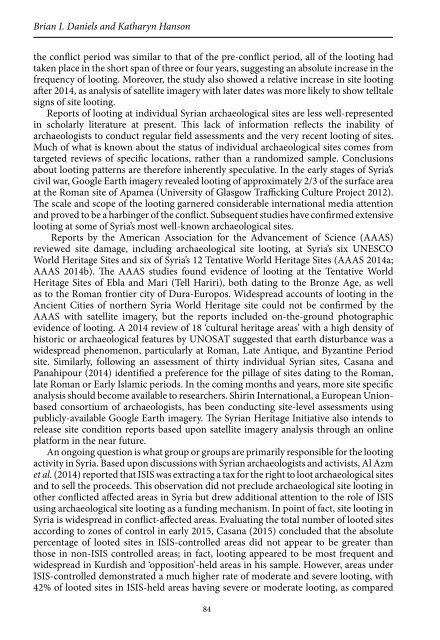Countering
Book_observatory_illicit_traffic_version%20issuu
Book_observatory_illicit_traffic_version%20issuu
You also want an ePaper? Increase the reach of your titles
YUMPU automatically turns print PDFs into web optimized ePapers that Google loves.
Archaeological Site Looting in Syria and Iraq<br />
to 23% in regime-controlled areas, 14% in ‘opposition’-held areas, and 9% in Kurdishheld<br />
areas. Extreme looting at sites like Dura-Europos and Mari (see case studies below)<br />
also appeared to have occurred after ISIS took control of the areas surrounding those<br />
sites. The discrepancy suggests that while looting is more frequent in areas outside of<br />
ISIS’s control, it is more intense in areas where ISIS does have control. Casana attributes<br />
the frequency of looting to weak centralized authority in Kurdish and ‘opposition’-held<br />
areas and suggests that the presence of moderate or severe looting, particularly in areas<br />
under ISIS control or regime control, may be indicative of some form of tacit support or<br />
formal consent from authorities.<br />
Summary of looting in Iraq<br />
During the 2003 Gulf War, the looting of the National Museum of Iraq in Baghdad<br />
briefly brought the plight of the country’s ancient artifacts into public awareness. Yet,<br />
the longstanding and ongoing looting at archaeological sites throughout Iraq was<br />
largely ignored outside of the cultural heritage community. The history of looting at<br />
archaeological sites in Iraq is long, and was shaped by the many political and economic<br />
issues that have faced Iraq since the late 19 th century. During the 1990s, Iraq’s economic<br />
situation worsened with the imposition of UN sanctions and, in southern Iraq, the<br />
impoverished population suffered from a severe lack of water, exacerbated by the<br />
draining of the marshes. Very little protection was offered to archeological sites by the<br />
central government (Gibson 1997; Stone 2015). Market demand for Iraqi antiquities<br />
in the 1990s was noted by John Russell (1996), who observed that Assyrian sculptures<br />
and reliefs began to appear on the market around that time. The proliferation of Iraqi<br />
artifacts on the international art market mirrored a substantial increase in illegal digging<br />
and smuggling. Nine out of 13 of Iraq’s regional museums were looted in addition<br />
to archaeological sites throughout the country. In response, the Iraqi government<br />
sponsored emergency excavations and guards for the archaeological sites. Both efforts<br />
led to a decrease in looting by the late 1990s (Gibson 2003).<br />
After 2003, several general overviews were published about archaeological site<br />
looting (Emberling and Hanson 2008; Fisk 2008; Gibson 2008; Rothfield 2009; Stone<br />
2015; Stone 2008; Stone and Bajjaly 2008). Initial ground observations showed that<br />
looters favored previously excavated sites already known to have produced valuable<br />
items. In the process, looters destroyed small, previously unknown archaeological sites<br />
across southern Iraq (Gibson 2003). The severity and extent of looting has been difficult<br />
to document from the ground due to periods of political instability and the limited<br />
resources of the Iraqi State Board of Antiquities have also been unable to keep pace with<br />
the rate of destruction. Thus, as with Syria, reviews have relied on satellite imagery to<br />
assess site damage (Global Heritage 2011; Hanson 2011; Hritz 2008; Russell 2008; Stone<br />
2008; Stone 2015; Ur 2014).<br />
To date, Elizabeth Stone’s (2008; 2015) overviews remain the comprehensive surveys<br />
of looting in southern Iraq. These studies relied upon remote sensing technologies to<br />
show patterns of looting at large and small archaeological sites in over 10,000 square<br />
kilometres of southern Iraq (Stone 2008a). Although Stone’s assessments do not discuss<br />
the status of specific sites in detail, they do provide an overview of the sheer scale of<br />
site pillage. Stone concludes that, of the 1,465 surveyed archaeological sites included in<br />
her study, the majority of site looting took place between February and August 2003,<br />
and, 12 years later, 23% of the sites showed damage (Stone 2015). Stone suggests that it<br />
85


